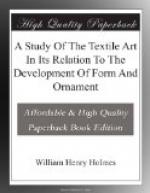[Illustration: Fig. 320. Coiled basket with simple geometric ornament. Work of the northwest coast Indians—1/8.]
I will now present the examples, which for the sake of uniformity are in all cases of the coiled ware. If a basket is made with no other idea than that of use the surface is apt to be pretty uniform in color, the natural color of the woof fillets. If decoration is desired a colored fillet is introduced, which, for the time, takes the place and does the duty of the ordinary strand. Fig. 319 serves to show the construction and surface appearance of the base of a coil made vessel still quite free from any color decoration. Now, if it is desired to begin a design, the plain wrapping thread is dropped and a colored fillet is inserted and the coiling continues. Carried once around the vessel we have an encircling line of dark color corresponding to the lower line of the ornament seen in Fig. 320. If the artist is content with a single line of color he sets the end of the dark thread and takes up the light colored one previously dropped and continues the coiling. If further elaboration is desired it is easily accomplished. In the example given the workman has taken up the dark fillet again and carried it a few times around the next turn of the warp coil; then it has been dropped and the white thread taken up, and again, in turn, another dark thread has been introduced and coiled for a few turns, and so on until four encircling rows of dark, alternating rectangles have been produced. Desiring to introduce a meandered design he has taken the upper series of rectangles as bases and adding colored filaments at the proper time has carried oblique lines, one to the right and the other to the left, across the six succeeding ridges of the warp coil. The pairs of stepped lines meeting above were joined in rectangles like those below, and the decoration was closed by a border line at the top. The vessel was then completed in the light colored material. In this ornament all forms are bounded by two classes of lines, vertical and horizontal (or, viewed from above or below, radial and encircling), the lines of the warp and the woof. Oblique bands of color are made up of series of rectangles, giving stepped outlines. Although these figures are purely geometric, it is not impossible that in their position and grouping they preserve a trace of some imitative conception modified to this shape by the forces of the art. They serve quite as well, however, to illustrate simple mechanical elaboration as if entirely free from suspicion of associated ideas.
[Illustration: Fig. 321. Coiled basket with encircling bands of ornament in white, red, and black, upon a yellowish ground. Obtained from the Indians of the Tule River, California—1/8.]
In Fig. 321 I present a superb piece of work executed by the Indians of the Tule River, California. It is woven in the closely impacted, coiled style. The ornament is arranged in horizontal zones and consists of a series of diamond shaped figures in white with red centers and black frames set side by side. The processes of substitution where changes of color are required are the same as in the preceding case and the forms of figures and the disposition of designs are the same, being governed by the same forces.




